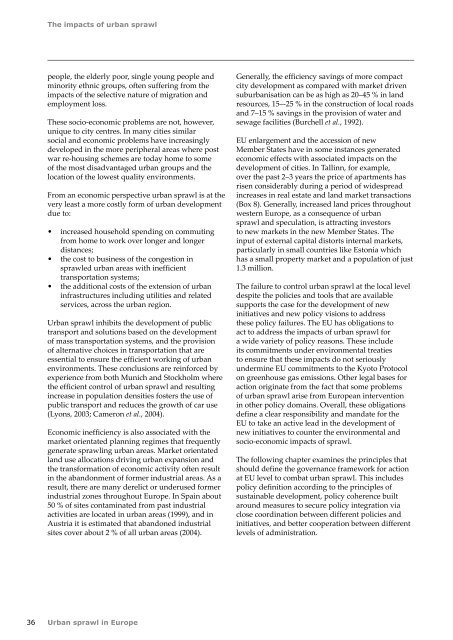Session 1 - Montefiore
Session 1 - Montefiore
Session 1 - Montefiore
Create successful ePaper yourself
Turn your PDF publications into a flip-book with our unique Google optimized e-Paper software.
36<br />
The impacts of urban sprawl<br />
people, the elderly poor, single young people and<br />
minority ethnic groups, often suffering from the<br />
impacts of the selective nature of migration and<br />
employment loss.<br />
These socio-economic problems are not, however,<br />
unique to city centres. In many cities similar<br />
social and economic problems have increasingly<br />
developed in the more peripheral areas where post<br />
war re-housing schemes are today home to some<br />
of the most disadvantaged urban groups and the<br />
location of the lowest quality environments.<br />
From an economic perspective urban sprawl is at the<br />
very least a more costly form of urban development<br />
due to:<br />
• increased household spending on commuting<br />
from home to work over longer and longer<br />
distances;<br />
• the cost to business of the congestion in<br />
sprawled urban areas with inefficient<br />
transportation systems;<br />
• the additional costs of the extension of urban<br />
infrastructures including utilities and related<br />
services, across the urban region.<br />
Urban sprawl inhibits the development of public<br />
transport and solutions based on the development<br />
of mass transportation systems, and the provision<br />
of alternative choices in transportation that are<br />
essential to ensure the efficient working of urban<br />
environments. These conclusions are reinforced by<br />
experience from both Munich and Stockholm where<br />
the efficient control of urban sprawl and resulting<br />
increase in population densities fosters the use of<br />
public transport and reduces the growth of car use<br />
(Lyons, 2003; Cameron et al., 2004).<br />
Economic inefficiency is also associated with the<br />
market orientated planning regimes that frequently<br />
generate sprawling urban areas. Market orientated<br />
land use allocations driving urban expansion and<br />
the transformation of economic activity often result<br />
in the abandonment of former industrial areas. As a<br />
result, there are many derelict or underused former<br />
industrial zones throughout Europe. In Spain about<br />
50 % of sites contaminated from past industrial<br />
activities are located in urban areas (1999), and in<br />
Austria it is estimated that abandoned industrial<br />
sites cover about 2 % of all urban areas (2004).<br />
Urban sprawl in Europe<br />
Generally, the efficiency savings of more compact<br />
city development as compared with market driven<br />
suburbanisation can be as high as 20–45 % in land<br />
resources, 15–-25 % in the construction of local roads<br />
and 7–15 % savings in the provision of water and<br />
sewage facilities (Burchell et al., 1992).<br />
EU enlargement and the accession of new<br />
Member States have in some instances generated<br />
economic effects with associated impacts on the<br />
development of cities. In Tallinn, for example,<br />
over the past 2–3 years the price of apartments has<br />
risen considerably during a period of widespread<br />
increases in real estate and land market transactions<br />
(Box 8). Generally, increased land prices throughout<br />
western Europe, as a consequence of urban<br />
sprawl and speculation, is attracting investors<br />
to new markets in the new Member States. The<br />
input of external capital distorts internal markets,<br />
particularly in small countries like Estonia which<br />
has a small property market and a population of just<br />
1.3 million.<br />
The failure to control urban sprawl at the local level<br />
despite the policies and tools that are available<br />
supports the case for the development of new<br />
initiatives and new policy visions to address<br />
these policy failures. The EU has obligations to<br />
act to address the impacts of urban sprawl for<br />
a wide variety of policy reasons. These include<br />
its commitments under environmental treaties<br />
to ensure that these impacts do not seriously<br />
undermine EU commitments to the Kyoto Protocol<br />
on greenhouse gas emissions. Other legal bases for<br />
action originate from the fact that some problems<br />
of urban sprawl arise from European intervention<br />
in other policy domains. Overall, these obligations<br />
define a clear responsibility and mandate for the<br />
EU to take an active lead in the development of<br />
new initiatives to counter the environmental and<br />
socio-economic impacts of sprawl.<br />
The following chapter examines the principles that<br />
should define the governance framework for action<br />
at EU level to combat urban sprawl. This includes<br />
policy definition according to the principles of<br />
sustainable development, policy coherence built<br />
around measures to secure policy integration via<br />
close coordination between different policies and<br />
initiatives, and better cooperation between different<br />
levels of administration.











